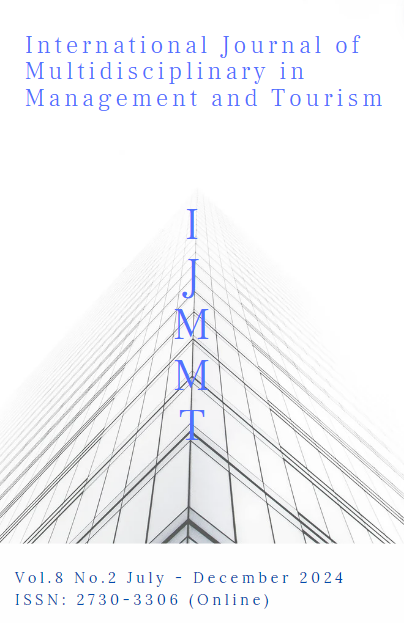The Two-Way Influencing Mechanism Between Corporate Governance Structure and Equity Market Performance in China’s Health and Tourism Industry
Main Article Content
Abstract
This article aimed to study the interactive relationship between corporate governance structure and equity market performance. The China Securities Regulatory Commission (CSRC) classifies listed companies in the A-share market into different industries, each of which represents a different field of economic activity. One of these industries is the health and tourism industry. The sample for this study includes seven Chinese listed companies in the health and tourism industry. Data were collected through interviews and analysed qualitatively. The research results are as follows:
1. A strong governance structure can effectively reduce investors' expected risk for stock investments. This risk reduction can be attributed to several key elements of corporate governance, including transparent decision-making processes, clear accountability, and effective risk management mechanisms.
2. Empirical evidence further confirms the direct link between the quality of corporate governance and the financial health of firms. Firms with sound governance structures not only enhance their attractiveness to investors but may also increase stock returns.
3. The empirical study of Chinese listed companies in the health and tourism industry specifically points out that good corporate governance is not only a determining factor in achieving financial success, but that it can indeed lead to positive results.
The findings emphasize the importance of prioritizing and continuously improving corporate governance, which is beneficial for both the company and its stakeholders. By ensuring a sound governance structure, companies can better manage risks, increase transparency, enhance market trust and ultimately achieve long-term financial soundness and growth.
Article Details

This work is licensed under a Creative Commons Attribution-NonCommercial-NoDerivatives 4.0 International License.
References
Avramov, D., Cheng, S., Lioui, A., & Tarelli, A. (2022). Sustainable investing with ESG rating uncertainty. Journal of Financial Economics, 145 (2B), 642-664. https://doi.org /10.1016/j.jfineco.2021.09.009
Bolton, P., & Kacperczyk, M. (2021). Do investors care about carbon risk? Journal of Financial Economics, 142(2), 517-549. https://doi.org/10.1016/j.jfineco.2021.05.008
Broadstock, D., Chan, K., Cheng, L., & Wang, X. (2020). The role of ESG performance during times of financial crisis: Evidence from COVID-19 in China, Finance Research Letters, 38, 101716. https://doi.org/10.1016/j.frl.2020.101716
Chabi-Yo, F., Leisen, D., & Renault, E. (2014), Aggregation of preferences for skewed asset returns. Journal of Economic Theory, 154, 453-489. https://doi.org/10.1016/j.jet. 2014.09.020
DasGupta, R. (2022). Financial performance shortfall, ESG controversies, and ESG performance: Evidence from firms around the world. Finance Research Letters, 46, 102487. https://doi.org/10.1016/j.frl.2021.102487
Fafaliou, I., Giaka, M., Konstantios, D., & Polemis, M. (2022). Firms’ ESG reputational risk and market longevity: A firm-level analysis for the United States. Journal of Business Research, 149, 161-177. https://doi.org/10.1016/j.jbusres.2022.05.010
He, F., Qin, S., Liu, Y., & Wu, J. (2022). CSR and idiosyncratic risk: evidence from ESG information disclosure. Finance Research Letters, 49, 102936. https://doi.org/10.1016 /j.frl.2022.102936
Hong, H., & Kacperczyk, M. (2009). The price of sin: The effects of social norms on markets. Journal of Financial Economics, 93(1), 15-36. https://doi.org/10.1016/j. jfineco.2008.09.001
Jin, A. (2021). Research on high ESG investment preferences of insurance funds--analysis based on long-term value investment path of companies. Finance and Economics, 11, 14-24.
Li, H., & Huang, X. (2011), Evaluation of investment value in China’s tourism industry: A study based on capital market perspective. Tourism Tribune, 26(08), 12-16.
Li, H., Tan, Y., & Chen, Q. (2018). A study on the factors influencing the asset restructuring decision of listed tourism enterprises in China. Research on Information and Management, 3, 96-108.
Li, H., Zhang, X., & Zhao, Y. (2022). ESG and firm's default risk. Finance Research Letters, 47, 102713. https://doi.org/10.1016/j.frl.2022.102713
Li, X., Xu, F., & Jing, K. (2022). Robust enhanced indexation with ESG: An empirical study in the Chinese stock market. Economic Modelling, 107, 105711. https://doi.org/10. 1016/j.econmod.2021.105711
Lin, Y., Fu X., & Fu X. (2021). Varieties in state capitalism and corporate innovation: Evidence from an emerging economy. Journal of Corporate Finance, 67, 101919. https://doi.org/10.1016/j.jcorpfin.2021.101919
Lioui, A., & Tarelli, A. (2022). Chasing the ESG factor. Journal of Banking and Finance, 139, 106498. https://doi.org/10.1016/j.jbankfin.2022.106498
Lööf, H., Sahamkhadam M., & Stephan A. (2022). Is corporate social responsibility investing a free lunch? the relationship between ESG, tail risk, and upside potential of stocks before and during the COVID-19 crisis. Finance Research Letters, 46, 102499. https://doi.org/10.1016/j.frl.2021.102499
Ma, X., Wang, J., & Qin, E. (2016). ESG disclosure system of listed companies. China Finance, 16, 33-34.
Pedersen, L., Fitzgibbons, S., & Pomorski, L. (2021). Responsible investing: The ESG-efficient frontier. Journal of Financial Economics, 142(2), 572-597. https://doi.org/ 10. 1016/j.jfineco.2020.11.001
Qian, Y. (2021). A study on the impact of earnings management on business performance of listed companies based on enterprise life cycle: A case study of tourism listed companies. Chinese and foreign corporate culture, 63-64.
Qiu M. Y., & Yin, H. (2019). ESG performance and financing cost of enterprises under the background of ecological civilization construction. Journal of Quantitative & Technical Economics, 36, 108-123. https://doi.org/10.13653/J.CNKI.Jqte.2019.03.007
Song, J. (2019). Research on issues related to the acquisition of listed companies by state owned assets - taking the holding of Jinhua tourism as an example. Contemporary Accounting, 13, 119-120.
Wang, X., & Shao, J. (2012), Discussion on issues related to the listing of tourist attraction companies. Journal of Chizhou University, 26(06), 75-77.
Xu, Z., Zhang, H., & Zhang, C. (2019), The impact of earnings management on business performance of tourism listed companies: A study based on the life cycle of enterprises. Tourism Tribune, 34(10), 76-92.
Yang, Y., Orzes, G., Jia, F., & Chen, L. (2021), Does GRI sustainability reporting pay off? an empirical investigation of publicly listed firms in China. Business & Society, 60(7), 1738–1772. https://doi.org/10.1177/0007650319831632
Zhang, X., Zhao, X., & Qu, L. (2021), Do green policies catalyze green investment? Evidence from ESG investing developments in China. Economics Letters, 207, 110028. https://doi.org/10.1016/j.econlet.2021.110028

